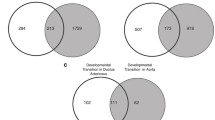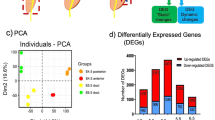Abstract
The ductus arteriosus (DA) of oviparous animals differs from mammals’ in the embryonic gas exchange system and its anatomy. We performed transcriptional analysis of chicken DA, attempting to elucidate the similarity and diversity in the mechanism of DA closure among species.
You have full access to this open access chapter, Download conference paper PDF
Similar content being viewed by others
Keywords
The ductus arteriosus (DA) of oviparous animals differs from mammals’ in the embryonic gas exchange system and its anatomy. We performed transcriptional analysis of chicken DA, attempting to elucidate the similarity and diversity in the mechanism of DA closure among species.
Chicken DA proximal to the pulmonary arteries (proximal DA) closes after hatching while the DA proximal to the aorta (distal DA) remains open even after hatching [1]. Histological analysis revealed that the ductal wall of the proximal DA became thicker with fragmented elastic fibers from embryonic day (ED) 19. Therefore, we performed microarray analysis with proximal DA, distal DA, and aorta from chicken embryo at ED19. Clustering analysis found that the expression pattern of distal DA was similar to that of proximal DA than that of aorta although distal DA has a similar structure to aorta. Subsequent pathway analysis with DAVID [2] revealed that proximal DA had enhanced expression of the melanogenetic genes compared with distal DA and aorta (Table 40.1). This result appears reasonable because proximal DA shares its developmental origin, neural crest, with melanocytes. Although several known genes such as transcription factor AP-2 beta (tfap2b) [3] were highly expressed in proximal and distal DA, we newly found proximal-DA-dominant genes. Further investigation would be required to understand the role of these genes in DA closure not only for the chick but also for mammals.
References
Belanger C, Copeland J, et al. Morphological changes in the chicken ductus arteriosi during closure at hatching. Anat Rec (Hoboken). 2008;291:1007–15. https://doi.org/10.1002/ar.20720.
Huang da W, Sherman BT, et al. Systematic and integrative analysis of large gene lists using DAVID bioinformatics resources. Nat Protoc. 2009;4:44–57. https://doi.org/10.1038/nprot.2008.211.
Zhao F, Bosserhoff AK, et al. A heart-hand syndrome gene: Tfap2b plays a critical role in the development and remodeling of mouse ductus arteriosus and limb patterning. PLoS One. 2011;6:e22908. https://doi.org/10.1371/journal.pone.0022908.
Acknowledgment
This work was supported by grants from the Ministry of Education, Culture, Sports, Science and Technology of Japan (T.A., S.M.), MEXT-Supported Program for the Strategic Research Foundation at Private Universities (S.M.), the Vehicle Racing Commemorative Foundation (S.M.), The Jikei University Graduate Research Fund (S.M.), and the Miyata Cardiology Research Promotion Foundation (S.M.).
Author information
Authors and Affiliations
Corresponding author
Editor information
Editors and Affiliations
Rights and permissions
Open Access This chapter is licensed under the terms of the Creative Commons Attribution 4.0 International License (http://creativecommons.org/licenses/by/4.0/), which permits use, sharing, adaptation, distribution and reproduction in any medium or format, as long as you give appropriate credit to the original author(s) and the source, provide a link to the Creative Commons license and indicate if changes were made.
The images or other third party material in this chapter are included in the chapter's Creative Commons license, unless indicated otherwise in a credit line to the material. If material is not included in the chapter's Creative Commons license and your intended use is not permitted by statutory regulation or exceeds the permitted use, you will need to obtain permission directly from the copyright holder.
Copyright information
© 2020 The Author(s)
About this paper
Cite this paper
Shinjo, S., Akaike, T., Ohmori, E., Kajimura, I., Goda, N., Minamisawa, S. (2020). Transcriptional Profiles in the Chicken Ductus Arteriosus During Hatching. In: Nakanishi, T., Baldwin, H., Fineman, J., Yamagishi, H. (eds) Molecular Mechanism of Congenital Heart Disease and Pulmonary Hypertension. Springer, Singapore. https://doi.org/10.1007/978-981-15-1185-1_40
Download citation
DOI: https://doi.org/10.1007/978-981-15-1185-1_40
Published:
Publisher Name: Springer, Singapore
Print ISBN: 978-981-15-1184-4
Online ISBN: 978-981-15-1185-1
eBook Packages: MedicineMedicine (R0)




